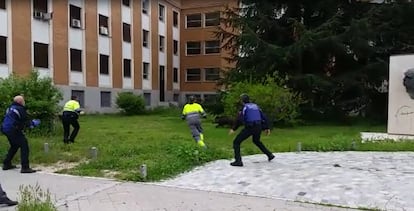How Spain’s coronavirus lockdown could be endangering wildlife
Researchers warn that the reduced presence of people and cars may encourage animals to venture into areas that will be unsafe for them once the confinement measures end


The hooting of the tawny owl in Maresme, a coastal comarca in Barcelona province, caught the attention of biologist Oriol Lapiedra. A member of staff at the Center for Ecological Research and Forestry Applications (CREAF), Lapiedra says it is unusual for this nocturnal bird of prey to leave the Collserola forests or the Sierra del Litoral to nest in built-up areas. But the current coronavirus lockdown, which has been in place since March 14, has turned Spain’s towns and cities into environments of unprecedented calm that are proving irresistible to some members of the animal kingdom.
But, as Lapiedra points out, the calm will not last forever and the risk is that these tawny owls will grow used to inhabiting an area that will once again threaten their existence.
If birds breed in areas where they didn’t breed before, reproduction could fail once activity returns to a certain level of normalityCenter for Ecological Research and Forestry Applications (CREAF)
CREAF, an institute of Barcelona’s Autonomous University that is attached to the Spanish National Research Council (CSIC), warns that the reduced presence of people in open spaces will be an ecological trap for many animals, creating “a false perception that cities are suitable places to live.”
The possible negative impacts on animals may be exacerbated by the fact that the coronavirus outbreak has coincided with the breeding season of many species, adds CREAF. “If, for example, birds take advantage of the lack of human disruption to breed in areas where they didn’t breed before, reproduction could fail once activity returns to a certain level of normality,” states a report from the center, which warns that aquatic insects, such as the Mayfly, could confuse street tarmac with water and lay their eggs there. When traffic returns to normal levels, the offspring could be destroyed.
Another species that could be attracted to roads are snakes, according to Lapiedra, who explains that the cold-blooded animal may take advantage of the reduced traffic to venture out onto the heat-retaining tarmac. As a result, more snakes could be run over once cars return.
Animals in rural areas are also at risk, says Lapiedra, who warns that the lockdown could encourage adaptable mammals like the wolf to wander closer to residential areas. “If we emerge from our homes when the [wolf] litters are being born, there may be an increase in encounters and greater conflict,” he says. However, Lapiedra adds that until the end of the quarantine period when scientists are able to resume their fieldwork, it will be difficult to know with certainty how wildlife patterns are changing.
Increased risk at airports
Carme Rosell, director of Minuartia, a consultancy specializing in urban biodiversity management and wildlife conflict containment, confirms that in airports such as El Prat in Barcelona, they have had to increase their efforts to ward off birds like seagulls and cormorants. “They are getting the idea that airports are now safe areas for them,” she says. “And in the case of El Prat, there are canals and marshes with plenty of fish. This creates safety problems when mobility is resumed, both for the planes and the birds.” Rosell adds that there are signs that wild boar have also become more acclimatized to residential areas, which could lead to road accidents in the future.
But environmental organizations such as the Spanish Ornithological Society (SEO Birdlife) and the World Wildlife Fund (WWF) stress that the reduced human presence in urban areas will not last long enough to alter the behavior of fauna. “It is a very circumstantial situation and there will be a return to normality. The animals will go back into hiding,” says Luis Suárez, conservation coordinator for WWF Spain.
Suárez does concede, however, that there may be small animals, such as rabbits, that will rapidly expand their territory as they breed, and this will lead to an increase in wildlife-vehicle collisions. “We will have to wait for a complete reproductive cycle, until June or July, before we know the impact of confinement on the fauna,” he concludes.
Beatriz Sánchez, head of SEO Birdlife’s urban biodiversity program, agrees that changes in the ecosystem take many years. “Even if the restrictions [on movement] were extended by two years, it is not enough time for the birds to change their habits,” she says.
Sánchez adds that while there could be an impact on birds that have chosen to breed in urban areas, it would be a one-off occurrence. “The changes are likely to be ephemeral and most of their consequences will disappear when human activity returns to levels similar to those before the crisis,” he says.
According to José Ignacio Aguirre, a researcher with the Biodiversity Monitoring Group at the Complutense University of Madrid, “In biology, it’s very difficult to talk in absolutes. The question of whether it is an ecological trap will depend on each species and the length of time human activity is reduced.”
Aguirre’s team has been analyzing how nature adapts to cities and their outlying areas for more than 20 years. Aguirre himself stresses that it will take time before we can begin to compare current data with that of the past, though he doubts there will be much negative impact. “Species are very dynamic,” he says. “They adapt quickly, and even more so if it’s only a matter of months. When humans return, they will retreat. But as long as confinement is in sync with their biological cycle, rates of reproduction will be higher.”
English version by Heather Galloway.
Tu suscripción se está usando en otro dispositivo
¿Quieres añadir otro usuario a tu suscripción?
Si continúas leyendo en este dispositivo, no se podrá leer en el otro.
FlechaTu suscripción se está usando en otro dispositivo y solo puedes acceder a EL PAÍS desde un dispositivo a la vez.
Si quieres compartir tu cuenta, cambia tu suscripción a la modalidad Premium, así podrás añadir otro usuario. Cada uno accederá con su propia cuenta de email, lo que os permitirá personalizar vuestra experiencia en EL PAÍS.
¿Tienes una suscripción de empresa? Accede aquí para contratar más cuentas.
En el caso de no saber quién está usando tu cuenta, te recomendamos cambiar tu contraseña aquí.
Si decides continuar compartiendo tu cuenta, este mensaje se mostrará en tu dispositivo y en el de la otra persona que está usando tu cuenta de forma indefinida, afectando a tu experiencia de lectura. Puedes consultar aquí los términos y condiciones de la suscripción digital.









































